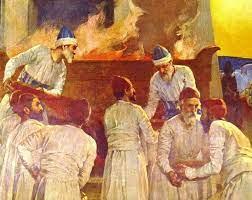Holiness for the Priests
21:1 to 22:33
All Isra’el was called to live by the mitzvot of holiness, but the priesthood, the cohenim, were called to an even higher standard of holiness than the average Israelite. In order to serve at the bronze altar for the sacrifices of the people, or in the Holy Place as mediators between YHVH and mankind, the priesthood, themselves, were required to live at a higher standard of holiness. They are the ones who present ADONAI with offerings made by fire, the bread of their God; therefore, they must be holy (Leviticus 21:6).371
This parashah (see the commentary on Deuteronomy, to see link click Af – Parashah) follows a section on holiness which began in Leviticus 17 (see Cy – The Holiness Code), where three levels of sanctification can be seen. First, the broad base of the nation (see Cz – Holiness for the People), then the level of Levites, who assisted the priests (see the commentary on Ezra-Nahemiah An – Priests, Levites and Temple Servants), and finally to the highest level, the priests (the kohanim), with the high priest himself who was the very summit of human holiness in Chapters 21 and 22.

The basic concept in these chapters is a basic review of the need for the priests to be ritually clean (see Bk – Ritually Clean and Unclean Animals) in order to perform their duties. But the teaching found here is more specific than what has previously been taught. For example, we are now informed that even if there is a small physical blemish such as a hunched back, or a broken arm (21:16-21), the man was disqualified from becoming the high priest. Thus, because these two chapters stress the need for the kohanim to be different from the rest of the Israelites, we find that most of the teaching is designed to give specific examples which would serve to remind the priests to be ritually clean. These examples cover every area of life; from what kind of woman to marry to skin blotches.372



Leave A Comment